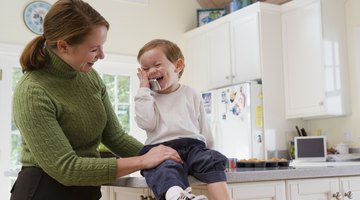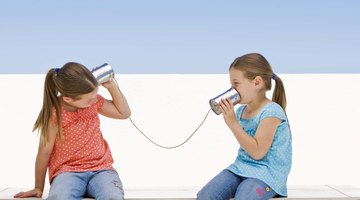What Is Toddler Jabbering?
Sometimes when you listen to your toddler, you would swear he's carrying on a full conversation -- in a foreign language. And he is, in a way. Toddler jabbering, more commonly known as jargoning, sounds like speech. It has inflections, pauses, and ebbs and flows. You might even pick out a few words here and there. Some of it must be funny, because your toddler might break out in giggles in the middle of a long speech. Jabbering is your toddler's way of getting ready to use language you can understand.
What It Is
Jargoning represents a normal part of speech progression in children; it follows cooing, babbling and canonical babbling -- the production of a long string of vowel-consonant sounds. The terms jabbering or jargoning describe a specific type of speech pattern common in toddler who hasn't acquired many actual words. Jargoning copies normal speech patterns; when your toddler jargons, it shows that he hears normal speech and that he understands that speech is a way to communicate.
When It Starts

The Average Words in an 18 Month Old's Vocabulary
Learn More
Most toddlers start to jargon between 12 and 18 months, certified pediatric nurse-practitioner Lisa-Ann Kelly reports on her website, PediatricAdvice.net. Between 15 and 18 months, your toddler will begin to slip some real words in among the jargon. Jargoning can sound amazingly like real speech, but while you might pick out a real word here and there, most jargoning isn't comprehensible to anyone but your toddler, who knows exactly what he's trying to say. By 24 to 30 months, jargoning should decrease and use of actual words take precedence, according to a June 2011 "Pediatrics in Review" article.
Purpose
Jabbering or jargoning is your toddler's attempt to communicate with you. Because he doesn't yet have the words to tell you what he wants or thinks, he "fills in the blanks" with made-up words or sounds. As his ability to communicate in real words progresses, his jargoning will decrease. Sometimes you can guess at what you toddler is trying to tell you and respond appropriately. Other times, an "Oh, really" or "Wow!" might be the most appropriate response you can muster. This can be frustrating for both you and toddler, if he doesn't feel as though you're understanding him. Using pictures or sign language can help bridge the gap, pediatric speech-language pathologist Laura Mize explains on her website, "Teach Me To Talk."
Problems

How Well Should a 2-Year-Old Talk?
Learn More
When children continue to use jargon past age 2, it can indicate a speech, hearing or developmental problem or delay. By age 2, strangers should be able to understand about 50 percent of what your toddler says. By age 3, 75 percent of what he says should be intelligible to other people, according to the textbook "Pediatrics." Because you're used to the way he speaks, 90 percent of what he says should make sense to you by age 3, according to Mize. If you feel as though your child isn't meeting speech milestones, talk to his pediatrician about a speech evaluation.











